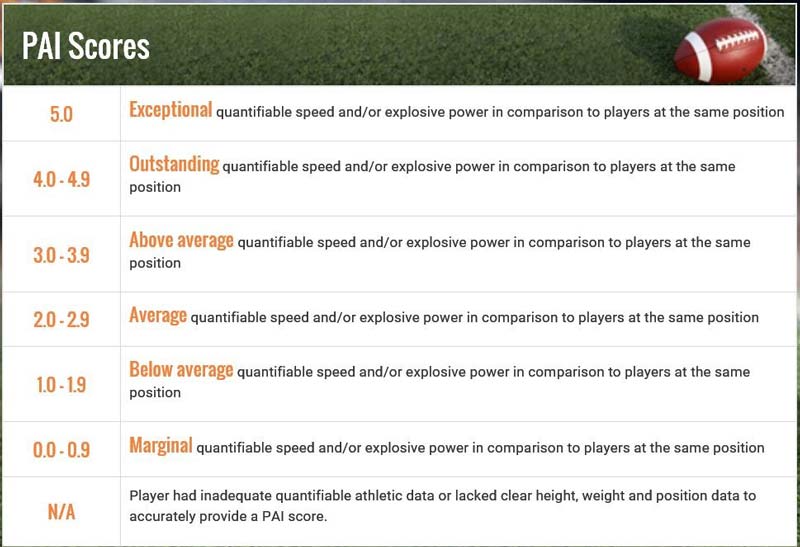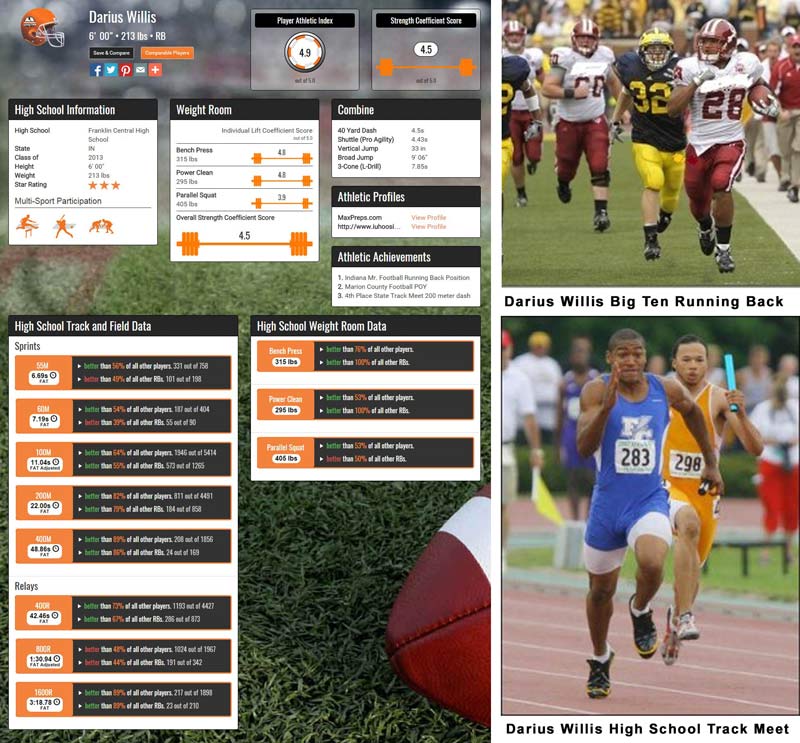
By Mark Branstad, Founder Tracking Football
“TrackingFootball.com is at the forefront of extrapolating data that could begin to quantify the benefits of playing secondary sports — namely track — as they relate to football.”
– Dallas Jackson, Creator of NationalHSFootball.com
Track and Football Connection
More than 1.1 million high school athletes play high school football each year and over 600,000 male athletes participate in high school track and field. These numbers indicate only a portion of what is a truly a complimentary connection between football and track. Each year almost 60% of football players drafted by the NFL participated in high school track and field; more than half of all Division I-FBS football recruits participate in track and field. A terrific article on this subject, published by FreelapUSA.com, was written by track and football coach Tony Holler.
![]()
TrackingFootball.com was created to research this connection and take a much closer look at the multi-sport connection that exists between football and other sports. Approximately ten years ago, Mark Branstad (founder of TrackingFootball.com) began researching the athletic backgrounds of tens of thousands of college and NFL players. Specifically he began gathering track and field stats and data on individual sport participation by players.
Over time, Mark’s database grew to over 25,000 players spanning from the 1970s to current college and pro players. Eventually, the high school track data began to show solid correlations between individual track performance and the likelihood of player advancement from one level of football to the next. Certainly the high school track data provided hints of overall athleticism, but it also provided some intangible information. Data indicates that competition in other sports and exposure to other athletic disciplines might play a role in football development. Dallas Jackson, a former Rivals.com editor, recently wrote an article about TrackingFootball’s use of track data for football athletic rating purposes. Jackson writes that despite pressures on today’s highly rated football recruits to focus exclusively on football, the vast majority continue to participate in high school track and other sports.
The Player Athletic Index
The observations led Mark and the other members of TrackingFootball to develop a football athletic rating system, the Player Athletic Index, or PAI. The Player Athletic Index is specifically designed to rate the overall athleticism of high school football players based on a variety of factors or metrics. The PAI give each player a score between 0 and 5.0 based on height, weight, football position, track and field performance data, and other high school multi-sport participation.

The PAI gives an easy-to-understand general athletic rating that allows high school athletes to compare themselves to each other and to former players. The PAI is based on objective measures such as track and field data, height and weight data while being position specific. Because track and field data is based on standardized distances, measures, methods, and weights, much of the subjectivity around the discussion of “football speed” and “football explosiveness” is eliminated. The PAI was not designed to determine football skill, but rather what level of overall athleticism, speed, and explosiveness a position player has, relative to another player.
The Strength Coefficient Score
TrackingFootball recently developed a strength coefficient scoring system for high school athletes in the weight room. The strength coefficient score is derived from weight room numbers of over 15,000 high school varsity players over the last decade. The data and scoring system was compiled and organized by high school coach Brian Spilbeler. The score is comprised of bench press, parallel squat and power clean lifting data, along with player bodyweight and a few additional proprietary calculations. Like the PAI, the strength coefficient is a score between 0 and 5.0. High school players can use the strength score to compare themselves against other current and local players, or to get a general sense of their relative strength in each lift.
TrackingFootball’s High School Profile System
How do high school players access TrackingFootball’s database of players and get PAI and strength coefficient scores? It’s easy! All high school players, freshmen to seniors, can create their own profiles on TrackingFootball.com, for FREE. Each player that creates a profile has access to every player profile in the system, including new profiles of current high school players. Every player that submits accurate track and field data will receive a PAI score. Additionally, every player that submits accurate lifting data will receive a strength coefficient score. The profile system is a great way for high school players to highlight their multi-sport athleticism and specific track and field data. All profiles and profile data are accessible by college coaches and recruiters. The system is completely FREE to high school players and athletes. High school players create your own profile today!
Below is a sample TrackingFootball.com high school profile.

How do football fans and track and field fans access this data?
Fans of track and field or football can go to TrackingFootball.com and sign-up for a FREE fan membership. (Requires active e-mail address.) This membership gives access to athletic and track data from TrackingFootball’s massive database of current and former college and NFL players. This data is not available anywhere else! The site is updated with new player profiles and athletic data every month.
For more site information and access to TrackingFootball’s social media pages:
Please share this article so others may benefit.
[mashshare]





